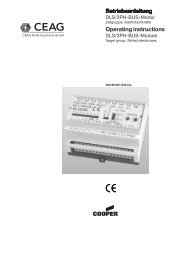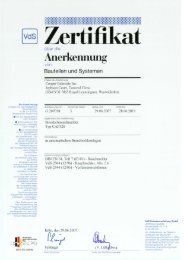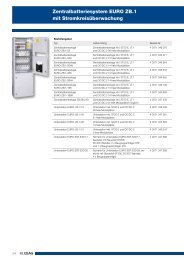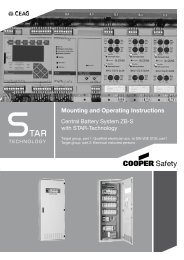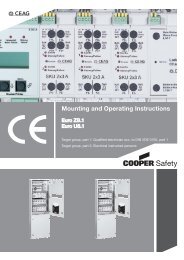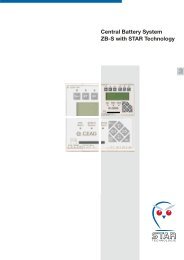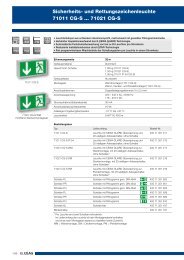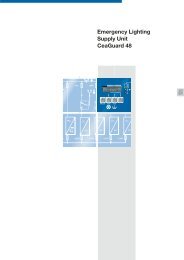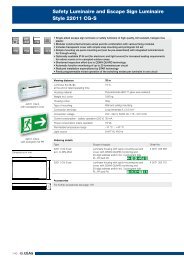TLS-BUS-Modul - CEAG
TLS-BUS-Modul - CEAG
TLS-BUS-Modul - CEAG
Create successful ePaper yourself
Turn your PDF publications into a flip-book with our unique Google optimized e-Paper software.
Montage- und Betriebsanleitung<br />
Mounting and Operating Instructions<br />
<strong>TLS</strong>-<strong>BUS</strong>-<strong>Modul</strong> / <strong>TLS</strong>-<strong>BUS</strong>-<strong>Modul</strong>e<br />
Zielgruppe: Elektrofachkraft<br />
Target group: Skilled electricians
2<br />
Montage und Betriebsanleitung<br />
DLS/3PH-<strong>BUS</strong>-<strong>Modul</strong><br />
Sicherheitshinweise<br />
� Das elektronische Überwachungsgerät<br />
<strong>TLS</strong>-<strong>BUS</strong>-<br />
<strong>Modul</strong> ist bestim mungs -<br />
gemäß in unbeschädigtem<br />
und einwandfreiem Zustand<br />
zu betreiben!<br />
� Bei Durchführung von Arbeiten<br />
am Gerät ist sicherzustellen,<br />
dass das Gerät<br />
span nungs frei geschaltet<br />
ist! Beachten Sie dabei<br />
die unter schiedlichen Versorgungen<br />
des Geräts bei<br />
Normal- und Notbetrieb.<br />
Anschluss T1/T2: max. je 50 mA<br />
z.B. 50 Taster<br />
mit Glimmlampe<br />
1 mA<br />
Anschluss K1/K2: 10 A /250 V AC<br />
Einschaltstrom<br />
max.120 A/ms<br />
Datenbus: RS 485<br />
Adressbereich: 1 - 25<br />
Gewicht: 0,2 kg<br />
Abmessungen<br />
L x B x H/mm: 105 x 85 x 60<br />
Montage: DIN-Schiene<br />
Anschlussklemmen:<br />
2,5 mm² starr<br />
und flexibel<br />
Funktionsweise<br />
Das <strong>TLS</strong>-Bus-<strong>Modul</strong> dient<br />
dem Betrieb und der Abfrage<br />
von beleuchteten Tastern (mit<br />
Glimmlampe 230V) wie z.B. in<br />
Treppenhäusern eingesetzt werden.<br />
Die Taster werden von einer<br />
<strong>CEAG</strong> Notlichtanlage mit einer<br />
gesicherten Spannung versorgt.<br />
Das <strong>Modul</strong> hat 2 Tasterstränge<br />
mit je einem zugehörigem potentialfreien<br />
Relaiskontakt zum<br />
Schalten der Allgemeinbeleuchtung.<br />
Die Anzeige von Taster<br />
und Relaisfunktion erfolgt mittels<br />
gelber LED. Das <strong>Modul</strong> ist<br />
� Beachten Sie bei allen Ar -<br />
beiten an dem Gerät die nationalen<br />
Sicherheits- und<br />
Unfallverhütungsvorschriften<br />
und die nachfolgenden<br />
Sicherheitshinweise in der<br />
Betriebsanleitung, die mit<br />
einem versehen sind!<br />
Normenkonformität<br />
Konform mit:<br />
EMV-Richtlinie 89/336/EWG,<br />
Niederspannungsrichtlinie<br />
73/236/EWG, EN 50081-1,<br />
EN 61000-6-2, EN 50178,<br />
Schaltschwellen gem.<br />
EN 60598-2-22, EN 50171 und<br />
VDE 0108.<br />
Gemäß DIN EN ISO 9001 entwickelt,<br />
gefertigt und geprüft.<br />
Technische Daten<br />
Versorgungsspannung<br />
Gerät: 24 V DC<br />
(min. 19 V,<br />
max. 30 V)<br />
Stromaufnahme bei 24 V<br />
Standby: 10 mA ± 3 mA<br />
1 gedr. Taster: 35 mA ± 5 mA<br />
2 gedr. Taster: 60 mA ± 6 mA<br />
Schutzart: IP 20<br />
Schutzklasse: I<br />
Umgebungstemperatur:<br />
-10 °C .. +40 °C<br />
Beschreibung/<br />
Verwendungsbereich<br />
Das elektronische Schaltgerät<br />
dient in Verbindung mit <strong>CEAG</strong><br />
Sicherheitsbeleuchtungsanlagen<br />
Typ ZB-S und<br />
CG 2000 zur Lichttasterabfrage,<br />
wodurch Leuchten der Allgemeinbeleuchtung<br />
und Leuchten<br />
der Sicherheitsbeleuchtung<br />
im Netzbetrieb innerhalb eines<br />
Treppenhauses gemeinsam geschaltet<br />
werden können.<br />
Installation<br />
Halten Sie die für das<br />
Errichten und Betreiben<br />
von elektrischen Be triebs mitteln<br />
geltenden Sicher heits vorschriften,<br />
das Geräte sicherheitsgesetz sowie<br />
die allgemein anerkannten<br />
Regeln der Technik ein!<br />
Montage<br />
Der Einbauort ist gemäß der einschlägigen<br />
Errichtungsnormen zu<br />
wählen (z.B. Unterverteilungen).<br />
Hierbei ist auf unzulässige Temperaturen<br />
am Einbauort während<br />
des Betriebs zu achten.<br />
über eine RS 485 Schnittstelle,<br />
der 24 V DC-Versorgung sowie<br />
einer gesicherten Spannung<br />
(zur Erzeugung der Glimmlampenspannung)<br />
mit der <strong>CEAG</strong><br />
Notlichtanlage verbunden.<br />
Die Tastfunktion wird an die<br />
<strong>CEAG</strong> Notlichtanlage über den<br />
<strong>BUS</strong> weitergeleitet. Die an der<br />
Notlichtanlage angeschlossenen<br />
Sicherheitsleuchten<br />
eines Kreises werden von der<br />
Anlage für die programmierte<br />
Treppen hauslichtzeit (1 - 15<br />
min) eingeschaltet. Gleichzeitig<br />
schließt der dem Strang zugehörige<br />
Relaiskontakt K1/K2 für<br />
die programmierte Zeitdauer,<br />
um ggf. zusätzliche Leuchten<br />
der Allgemeinbeleuchtung zu<br />
schalten. Damit kann der sonst<br />
übliche Treppenhausautomat<br />
entfallen.<br />
30 Sek. vor Ablauf der eingestellten<br />
Einschaltzeit beginnen<br />
die angeschlossenen Glimmlampen<br />
der Taster zu blinken.<br />
Die grüne LED in der Frontplatte<br />
signalisiert störungsfreien<br />
Betrieb, die rote LED zeigt eine<br />
Störung an. Werden mehrere<br />
<strong>Modul</strong>e (max. 25) an einer<br />
Anlage betrieben, so ist der<br />
RS 485 Bus wie auch die 24 V<br />
Versorgung hintereinander zu<br />
schalten. Der Schirm der <strong>BUS</strong>-
Montage und Betriebsanleitung<br />
DLS/3PH-<strong>BUS</strong>-<strong>Modul</strong><br />
T1 T1 X K1 K1 X K2 K2 X T2 T2 X<br />
max.10A<br />
<strong>TLS</strong> - <strong>BUS</strong> - <strong>Modul</strong><br />
400 71 346 965<br />
max.10A<br />
T1 K1 K2 T2<br />
+ 24V -<br />
N PE L<br />
(0) (U)<br />
2 3<br />
1<br />
0<br />
N<br />
X<br />
L<br />
X X + + +<br />
N PE PE<br />
- - - SE A SE A X<br />
Servicetaster zur Überprüfung der Kommunikation <strong>Modul</strong> -<br />
Sicherheitsbeleuchtungsanlage über den RS 485-<strong>BUS</strong><br />
7 Bild 18<br />
PE<br />
L2 Anschlussbild L3 <strong>TLS</strong> <strong>Modul</strong><br />
3PH<br />
DLS<br />
3 PH<br />
Out<br />
*<br />
1<br />
0<br />
address<br />
2 3<br />
1 2 3 4<br />
A B B1 B2<br />
X<br />
Bild 2<br />
Adress- Adressschalter<br />
1 schalter 2<br />
0<br />
9<br />
8<br />
7<br />
5<br />
6<br />
EIN / ON<br />
St”rung<br />
Failure<br />
RS485<br />
IN Out<br />
N N PE PE L L<br />
address<br />
1<br />
0<br />
2 3 4<br />
5<br />
9 6<br />
8 7<br />
B B B1 B2<br />
Adressschalter 1 Adressschalter 2 <strong>Modul</strong>adresse<br />
0 0 nicht zulässig<br />
0 1 1<br />
0 2 2<br />
... ... ...<br />
1 0 10<br />
1 1 11<br />
... ... ...<br />
... ... ...<br />
2 5 25<br />
2 6 nicht zulässig<br />
... ... ...<br />
3 9 nicht zulässig<br />
Leitung ist mit einer geeigneten<br />
Klemmvorrichtung an den<br />
Klemmen SE anzuschließen.<br />
Am Anfang und am Ende der<br />
<strong>BUS</strong>-Leitung ist jeweils ein Abschlusswiderstand<br />
(120 Ω)<br />
zu installieren. Hierfür sind im<br />
jeweils letzten <strong>Modul</strong> die Klemmen<br />
B1/B2 mit einer Brücke zu<br />
versehen, die den eingebauten<br />
Abschlusswiderstand aktiviert. Ist<br />
die Sicherheitsanlage Anfang der<br />
Busleitung, so ist an den hierfür<br />
vorgesehenen Klemmen der entsprechende<br />
Abschlusswiderstand<br />
zu installieren.<br />
Die Versorgung der Tasterglimmlampen<br />
mit einer gesicherten<br />
Netzspannung muss über eine<br />
separate Stromkreisumschaltung<br />
(SKU) von der Notlichtanlage erfolgen<br />
(gesichertes Netz).<br />
Adressierung<br />
Vor Betrieb an einer <strong>CEAG</strong>-<br />
Sicherheitsbeleuchtungsanlage<br />
muss die <strong>Modul</strong>adressierung<br />
vorgenommen werden. Hierzu ist<br />
mit einem geeigneten Schraubendreher<br />
die gewünschte Adresse (1<br />
- 25) an den zwei Codierschaltern<br />
in der Frontplatte des <strong>Modul</strong>s einzustellen<br />
(Pfeil auf Zahl, Bild 2).<br />
3
4<br />
Abschlusswiderstand*<br />
120 Ω<br />
Montage und Betriebsanleitung<br />
DLS/3PH-<strong>BUS</strong>-<strong>Modul</strong><br />
Bild 3: Schaltung eines <strong>TLS</strong>- <strong>BUS</strong>-<strong>Modul</strong>s<br />
<strong>TLS</strong><br />
DLS<br />
RS485-<strong>BUS</strong><br />
ZB-S<br />
<strong>TLS</strong><br />
max. 1200 m bei J-Y(ST)Y 4 x 2 x 0,8 mm<br />
DLS<br />
*Abschlusswiderstand<br />
120 Ω<br />
Bild 4.<br />
Busstruktur RS485-<strong>BUS</strong><br />
� Double Terminated Bus Topologie/Linienstruktur<br />
� max. 25 <strong>Modul</strong>e (DLS/<strong>TLS</strong>)<br />
� Querschnitt für 24 V-Versorgung ist gemäß Anzahl der MOdule sowie Leitungslänge zu berechnen.<br />
U für <strong>Modul</strong> = 19 V<br />
min<br />
� Empfolene Leitung: JY(ST)Y 4 x 2 x 0,8 mm, Twisted Pair (verdrillte Zweidraht-Leitung), geschirmt<br />
� Keine Stichleitungen zulässig!<br />
* Im <strong>TLS</strong>-Bus-<strong>Modul</strong> ist der 120 Ohm-Abschlußwiderstand integriert<br />
und kann durch eine Brücke an den Klemmen B1/B2 aktiviert werden.<br />
Bitte lesen Sie dazu auch Seite 3.
Mounting and Operating Instructions<br />
DLS/3PH-<strong>BUS</strong>-<strong>Modul</strong>e<br />
Safety<br />
Instructions<br />
� The electronic monitoring<br />
module shall only be used<br />
for its intended purpose and<br />
in undamaged and perfect<br />
condition!<br />
� When working on the<br />
electronic device make sure<br />
that it is disconnected from<br />
the voltage! Pay attention to<br />
the different power supplies<br />
in mains or battery<br />
operation.<br />
� Observe the national safety<br />
rules and regulations for<br />
prevention of accidents as<br />
well as the safety instructions<br />
included in these<br />
operating instruction marked<br />
with<br />
Conformity with<br />
standards<br />
Conforming to: EMC-directive<br />
89/336/EWG, Low Voltage Directive<br />
73/236/EWG,<br />
EN 50081-1, EN 61000-6-2,<br />
EN 50178, Switching point accd.<br />
EN 60598-2-22,<br />
EN 50171 and VDE 0108.<br />
Developed, manufactured and<br />
tested acc. to ISO 9001.<br />
Voltage supply<br />
module: 24 V DC<br />
(min. 19 V,<br />
max. 30 V)<br />
current consumption at 24 V<br />
Standby: 10 mA ± 3 mA<br />
1 pushed key: 35 mA ± 5 mA<br />
2 pushed keys: 60 mA ± 6 mA<br />
Degree of<br />
protection: IP 20<br />
Insulation class: I<br />
Perm. ambient<br />
temperature: -10 °C .. +40 °C<br />
Connection to<br />
T1/T2: max. each 50 mA<br />
e.g. 50 push-<br />
buttons with<br />
glow lamp 1 mA<br />
Connection to<br />
K1/K2: 10 A /250 V AC<br />
Inrush current<br />
max.120 A/ms<br />
Data bus: RS 485<br />
Address range: 1 - 25<br />
Weight: 0.2 kg<br />
Dimensions<br />
L x W x H/mm: 105 x 85 x 60<br />
Assembly: DIN-Rail<br />
Terminals: 2.5 mm² rigid<br />
and flexible<br />
Description/Scope of<br />
application<br />
The electronic switchgear is used<br />
in combination with <strong>CEAG</strong> safety<br />
lighting systems of type ZB-S and<br />
CG 2000 for light switch monitoring.<br />
In this way luminaires for<br />
general lighting and luminaires for<br />
safety lighting within a staircase<br />
can be switched together during<br />
mains operation.<br />
Installation<br />
For the mounting and<br />
operation of electrical<br />
apparatus, the respective national<br />
safety regulations as well as the<br />
general rules of engineering will<br />
have to be observed.<br />
Mounting<br />
Observe the safety regulations<br />
applicable for setting up and<br />
operating electrical equipment,<br />
the Geraetesicherheitsgesetz<br />
(German law on equipment safety)<br />
as well as generally recognised<br />
engineering principles!<br />
Assembly<br />
The installation location is to be<br />
chosen in accordance with the<br />
applicable construction standards<br />
(e.g. subdistribution boards). During<br />
this process attention is to be<br />
paid to temperatures outside the<br />
permitted range at the installation<br />
location during operation.<br />
Principle of operation<br />
The <strong>TLS</strong> bus module is used for<br />
operating and monitoring light<br />
switches (with glow lamp 230V),<br />
e.g., as are used in staircases.<br />
The switches are supplied from<br />
a <strong>CEAG</strong> emergency lighting system<br />
with a protected supply. The<br />
module has 2 switch phases each<br />
with a related potential-free relay<br />
contact for switching the general<br />
lighting. The switch and relay<br />
functions are displayed using a<br />
yellow LED. The module is connected<br />
to the <strong>CEAG</strong> emergency<br />
lighting system via an RS 485 interface,<br />
and to the 24 V DC supply<br />
as well as a protected supply (for<br />
the generation of the glow lamp<br />
supply).<br />
The monitoring function is forwarded<br />
to the <strong>CEAG</strong> emergency<br />
lighting system over the <strong>BUS</strong>. The<br />
safety luminaires on a circuit connected<br />
to the emergency lighting<br />
system are switched on by<br />
the system for the programmed<br />
staircase lighting time (1 - 15 min).<br />
At the same time, the relay contact<br />
K1/K2 related to the phase<br />
closes for the programmed time<br />
to switch on additional luminaires<br />
for the general lighting if necessary.<br />
In this way the staircase<br />
timer otherwise used is no longer<br />
required. 30 sec. prior to the end<br />
of the switch on time set, the glow<br />
lamps for the switches connected<br />
start to flash.<br />
The green LED on the front<br />
panel indicates malfunction-free<br />
operation; the red LED indi-<br />
5
* = 3PH<br />
6<br />
Mounting and Operating Instructions<br />
DLS/3PH-<strong>BUS</strong>-<strong>Modul</strong>e<br />
T1 T1 X K1 K1 X K2 K2 X T2 T2 X<br />
max.10A<br />
<strong>TLS</strong> - <strong>BUS</strong> - <strong>Modul</strong><br />
400 71 346 965<br />
max.10A<br />
T1 K1 K2 T2<br />
N PE L<br />
(0) (U)<br />
2 3<br />
1<br />
0<br />
1<br />
0<br />
2 3 4<br />
5<br />
9 6<br />
8 7<br />
+ 24V -<br />
RS485<br />
IN Out<br />
L N L N PE PE<br />
X X X + + + - - - SE A B SE A B X B1 B2<br />
Service key for testing of the communication between module -<br />
safety lighting via RS 485-<strong>BUS</strong><br />
7 8 PE<br />
fig. 1 Connections <strong>TLS</strong> module<br />
L2 L3<br />
* *<br />
DLS<br />
3 PH<br />
485 Out<br />
1<br />
0<br />
address<br />
2 3<br />
1 2 3 4<br />
SE A B X<br />
B1 B2<br />
0<br />
9<br />
8<br />
7<br />
fig. 2<br />
Address- Addressswitch<br />
1 switch 2<br />
5<br />
6<br />
EIN / ON<br />
St”rung<br />
Failure<br />
N N PE PE L L<br />
address<br />
Address swtch 1 Address switch 2 <strong>Modul</strong>e addresse<br />
0 0 not permissible<br />
0 1 1<br />
0 2 2<br />
... ... ...<br />
1 0 10<br />
1 1 11<br />
... ... ...<br />
... ... ...<br />
2 5 25<br />
2 6 not permissible<br />
... ... ...<br />
3 9 not permissible<br />
cates a malfunction. If several<br />
modules (max. 25) are operated<br />
in a system, then the RS 485<br />
bus and the 24 V supply are<br />
to be connected in series. The<br />
screen on the <strong>BUS</strong> cable is to<br />
be connected to the SE terminals<br />
using a suitable clamping<br />
arrangement.<br />
A terminating resistor (120 W)<br />
must be fitted at the start and<br />
end of the <strong>BUS</strong> cable. For this<br />
purpose, a jumper is to be fitted<br />
to terminals B1/B2 on the last<br />
module; this activates the builtin<br />
terminating resistor. If the<br />
safety system is at the start of<br />
the bus cable, then the appropriate<br />
terminating resistor is to<br />
be fitted to terminals provided<br />
for this purpose. The supply for<br />
the switch glow lamps with a<br />
protected mains supply must be<br />
provided from the emergency<br />
lighting system using a separate<br />
changeover circuit (protected<br />
mains).<br />
Addressing<br />
Prior to operation in a <strong>CEAG</strong><br />
safety lighting system, the<br />
module address must be set.<br />
For this purpose the required<br />
address (1 - 25) is to be set on<br />
the code switches on the module<br />
front panel using a suitable<br />
screwdriver (arrow to number,<br />
Figure 2).
Terminating*<br />
resistor<br />
120 Ω<br />
Mounting and Operating Instructions<br />
DLS/3PH-<strong>BUS</strong>-<strong>Modul</strong>e<br />
Safety lighting General lighting<br />
Light push-button<br />
fig. 3: Wiring of the <strong>TLS</strong>- <strong>BUS</strong>-<strong>Modul</strong>s<br />
<strong>TLS</strong><br />
DLS<br />
RS485-<strong>BUS</strong><br />
ZB-S<br />
<strong>TLS</strong><br />
max. 1200 m with J-Y(ST)Y 4 x 2 x 0.8 mm<br />
DLS<br />
*Terminating<br />
resistor<br />
120 Ω<br />
fig.4<br />
Bus structure RS485-<strong>BUS</strong><br />
� Double terminated bus topology/Line structure<br />
� max. 25 modules (DLS/<strong>TLS</strong>)<br />
� Cross section for 24 V supply must be calculated according the number of modules as well as line<br />
length. U for module = 19 V<br />
min<br />
� recommend cable: JY(ST)Y 4 x 2 x 0.8 mm, twisted pair, shielded<br />
� No dead-end lines allowed.<br />
* In <strong>TLS</strong>-Bus-modul the 120 ohms terminating resistor is integrated<br />
and can be activate through a wire fitted to terminals B1/B2.<br />
Please read back page 6.<br />
7
<strong>CEAG</strong> Notlichtsysteme GmbH<br />
Senator-Schwartz-Ring 26<br />
59494 Soest<br />
Germany<br />
Tel: +49 (0) 2921/69-870<br />
Fax: +49 (0) 2921/69-617<br />
Web: www.ceag.de<br />
Email: info-n@ceag.de<br />
300 80 001 643_B/XXX/04.12/WK<br />
Cooper Safety<br />
Jephson Court<br />
Tancred Close<br />
Royal Leamington Spa<br />
Warwickshire CV31 3RZ<br />
United Kingdom<br />
Tel: +44 (0) 1926 439200<br />
Fax: +44 (0) 1926 439240<br />
Web: www.cooper-safety.com<br />
Email: enquiries@cooper-safety.com






